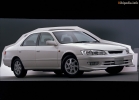Toyota Camry 1997 - 2001 Crash Test
Toyota Camry 1997, 1998, 1999, 2000, 2001: Laborator Assessment of the Car Safety: Rating in points, a report on the test (photo and video of the crash test)
25%
Driver and passengers
15%
Pedestrians
Protection of the driver and passenger
 Frontal blow, driver |
 Loba blow, passenger |
 Side blow, driver |
|
Children's holding devices
| Child up to 18 months | Roemer Peggy, facing forward |
| A child over 3 years old | Roemer Peggy, facing forward |
Safety of pedestrians
 |
|
Comments:
The good results of the side strike allowed Camry to enter the group of cars who received four stars. However, the result of the frontal blow spoiled the high risk of damage to the legs and feet of the driver, especially when the knees are hitting the front panel. Although for the test the manufacturer himself chose children's chairs, there are no recommendations to the buyer regarding these accessories. Using other seats can lead to excellent results. Protection for a lateral strike meets the safety requirements of 1998.Frontal blow:
The body frame retained integrity, and the driver’s safety pillow showed a good result, providing stable contact with his head. The front belts were equipped with pretense, but without locks. The chest did not reach the steering wheel, but the load on the chest from the seat belt can cause an injury, especially for the passenger. The lower part of the front panel can be dangerous for the knees, the upper part of the legs and the driver's pelvis. Finally, the brake pedal shifted back to a distance, sufficient to pose a threat to the feet and ankles.Safety of passenger children:
The rear row of seats was equipped with three inertial three -point seat belts, each of which had an automatic mechanism that allows you to reliably fix the children's chair. The instructions for their use were placed on the belts themselves. With an open door of the front passenger, the sticker “approved by the European Association of Manufacturers (ACEA)” is visible, and a sticker in three languages \u200b\u200bwas placed in the sunscreen. Britax Romer Peggy Universal, suitable for passengers weighing 9 to 18 kg and compatible with seat belts, took part in the test.Side blow:
Side airbags in the backs of the seats were included in the basic configuration of Toyota Camry. The driver's pillow showed a good result, distributing the load well and holding it at a low level. However, a door armrest hit the abdominal cavity.Pedestrian safety:
All control currents in the area of \u200b\u200bthe legs, with the exception of one on the front edge of the hood, provided poor protection. The child’s impact zone provides a greater mitigation of the blow than all other places, including the adult’s head.General information about the car
| The location of the steering wheel | Left |
| Tested model | Toyota Camry 2.2 |
| Type of body | 4-door sedan |
| Year of data publication | 1998 |
| Curb weight | 1385 |
Safety system equipment:
| Front seat belts | There is |
| Front seat belts load limiters | There is |
| Front Pillow of Safety of the driver | There is |
| Passenger front pillow | There is |
| Side airbags | There is |
| Side pillows of head safety pillows | Not |
| Knee -off pillow and legs of the driver | Not |












